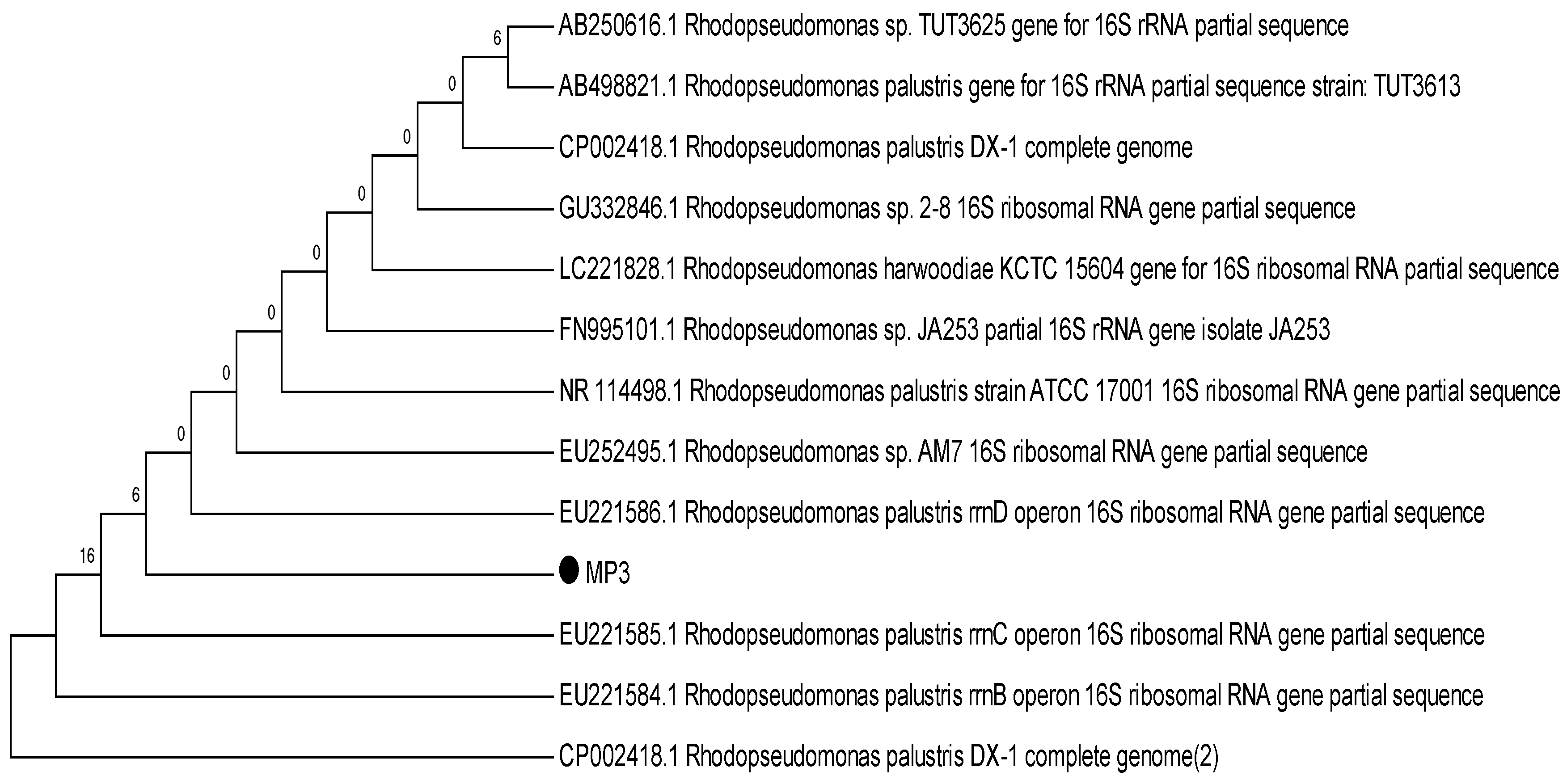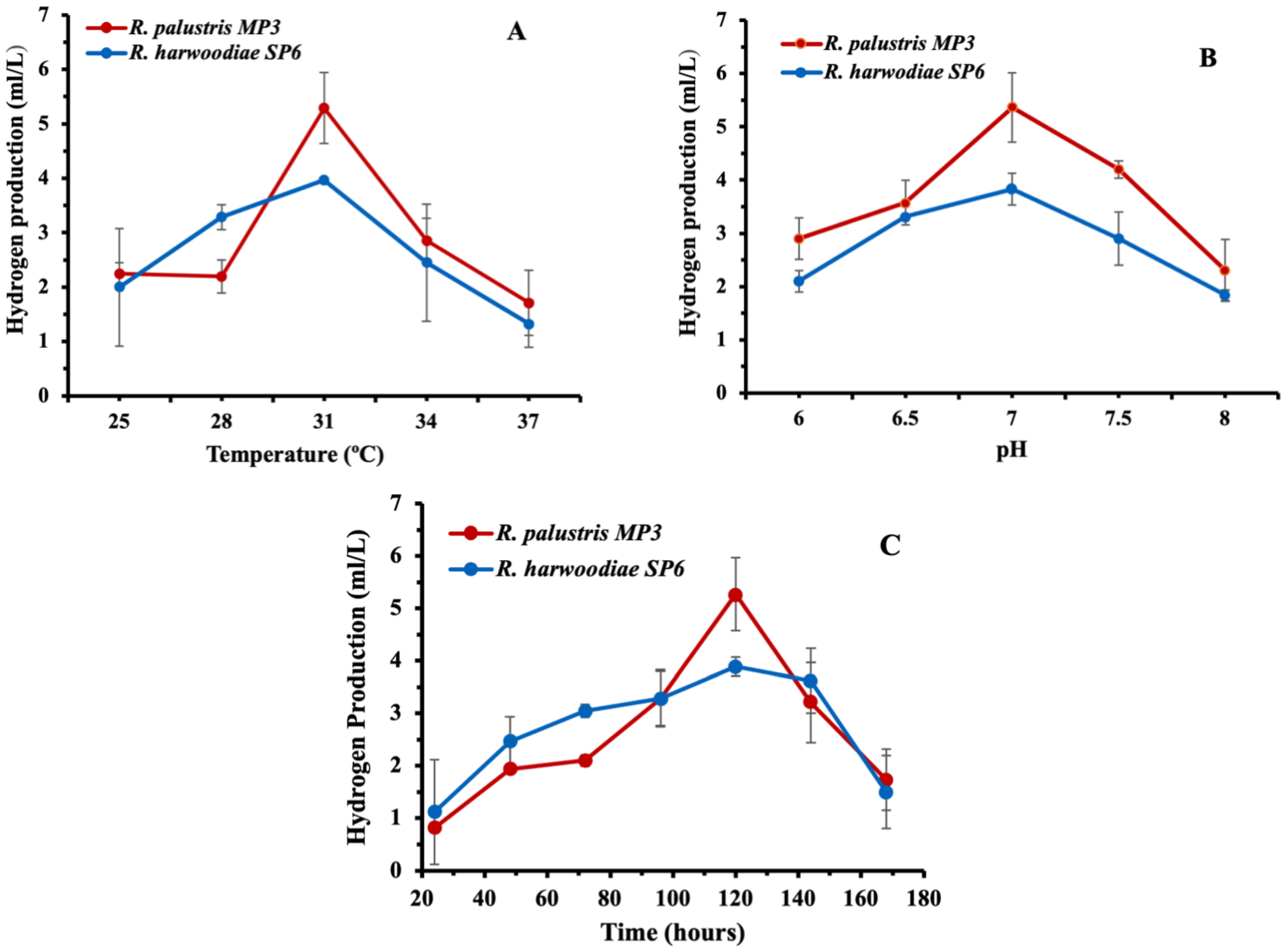Comparison of Hydrogen Production Efficiency by Rhodopseudomonas palustris MP3 and Rhodopseudomonas harwoodiae SP6 Using an Iron Complex as an Enhancement Factor
Abstract
:1. Introduction
2. Materials and Methods
3. Results
4. Conclusions
Supplementary Materials
Author Contributions
Funding
Data Availability Statement
Acknowledgments
Conflicts of Interest
References
- Hitam, C.N.C.; Jalil, A.A. A review on biohydrogen production through photo-fermentation of lignocellulosic biomass. Biomass Convers. Biorefinery 2023, 13, 8465. [Google Scholar] [CrossRef]
- Kanwal, F.; Torriero, A.A.J. Biohydrogen&Mdash; A Green Fuel for Sustainable Energy Solutions. Energies 2022, 15, 7783. [Google Scholar]
- Cheng, D.; Ngo, H.H.; Guo, W.; Chang, S.W.; Nguyen, D.D.; Bui, X.T.; Wei, W.; Ni, B.; Varjani, S.; Hoang, N.B. Enhanced photo-fermentative biohydrogen production from biowastes: An overview. Bioresour. Technol. 2022, 357, 127341. [Google Scholar] [CrossRef] [PubMed]
- Yoro, K.; Daramola, M.O. CO2 emission sources, greenhouse gases, and the global warming effect. In Advances in Carbon Capture; Woodhead Publishing: Sawston, UK, 2020; pp. 1–28. [Google Scholar]
- Kanmani, S. Enhancement of biological hydrogen production from organic wastes with the application of nanomaterials. Int. J. Energy Res. 2022, 46, 18929–18946. [Google Scholar] [CrossRef]
- Kanwal, F.; Tahir, A.; Qadir Shah, S.A.; Tsuzuki, T.; Nisbet, D.; Chen, J.; Rehman, Y. Effect of phyto-fabricated nanoscale organic-iron complex on photo-fermentative hydrogen production by Rhodopseudomonas palustris MP2 and Rhodopseudomonas palustris MP4. Biomass Bioenergy 2020, 140, 105667. [Google Scholar] [CrossRef]
- Saha, R.; Bhattacharya, D.; Mukhopadhyay, M. Enhanced production of biohydrogen from lignocellulosic feedstocks using microorganisms: A comprehensive review. Energy Convers. Manag. X 2022, 13, 100153. [Google Scholar] [CrossRef]
- Sun, Y.; He, J.; Yang, G.; Sun, G.; Sage, V. A review of the enhancement of bio-hydrogen generation by chemicals addition. Catalysts 2019, 9, 353. [Google Scholar] [CrossRef]
- Hosseinzadeh, A.; Zhou, J.L.; Li, X.; Afsari, M.; Altaee, A. Techno-economic and environmental impact assessment of hydrogen production processes using bio-waste as renewable energy resource. Renew. Sustain. Energy Rev. 2022, 156, 111991. [Google Scholar] [CrossRef]
- Lu, C.; Jiang, D.; Jing, Y.; Zhang, Z.; Liang, X.; Yue, J.; Li, Y.; Zhang, H.; Zhang, Y.; Wang, K.; et al. Enhancing photo-fermentation biohydrogen production from corn stalk by iron ion. Bioresour. Technol. 2022, 345, 126457. [Google Scholar] [CrossRef]
- Khetkorn, W.; Rastogi, R.P.; Incharoensakdi, A.; Lindblad, P.; Madamwar, D.; Pandey, A.; Larroche, C. Microalgal hydrogen production—A review. Bioresour. Technol. 2017, 243, 1194–1206. [Google Scholar] [CrossRef]
- Kim, D.-H.; Kim, M.-S. Hydrogenases for biological hydrogen production. Bioresour. Technol. 2011, 102, 8423–8431. [Google Scholar] [CrossRef] [PubMed]
- Xuan, J.; He, L.; Wen, W.; Feng, Y. Hydrogenase and Nitrogenase: Key Catalysts in Biohydrogen Production. Molecules 2023, 28, 1392. [Google Scholar] [CrossRef]
- Dolly, S.; Pandey, A.; Pandey, B.K.; Gopal, R. Process parameter optimisation and enhancement of photo-biohydrogen production by mixed culture of Rhodobacter sphaeroides NMBL-02 and Escherichia coli NMBL-04 using Fe-nanoparticle. Int. J. Hydrogen Energy 2015, 40, 16010–16020. [Google Scholar] [CrossRef]
- Zhu, H.; Fang, H.H.; Zhang, T.; Beaudette, L.A. Effect of ferrous ion on photo heterotrophic hydrogen production by Rhodobacter sphaeroides. Int. J. Hydrogen Energy 2007, 32, 4112–4118. [Google Scholar] [CrossRef]
- Adessi, A.; Venturi, M.; Candeliere, F.; Galli, V.; Granchi, L.; De Philippis, R. Bread wastes to energy: Sequential lactic and photo-fermentation for hydrogen production. Int. J. Hydrogen Energy 2018, 43, 9569–9576. [Google Scholar] [CrossRef]
- Tamura, K.; Peterson, D.; Peterson, N.; Stecher, G.; Nei, M.; Kumar, S. MEGA5: Molecular evolutionary genetics analysis using maximum likelihood, evolutionary distance, and maximum parsimony methods. Mol. Biol. Evol. 2011, 28, 2731–2739. [Google Scholar] [CrossRef] [PubMed]
- Felsenstein, J. Confidence Limits on Phylogenies: An Approach Using the Bootstrap. Evolution 1985, 39, 783–791. [Google Scholar] [CrossRef] [PubMed]
- Saleem, H.; ul Ain Kokab, Q.; Rehman, Y. Arsenic respiration and detoxification by purple non-sulphur bacteria under anaerobic conditions. C. R. Biol. 2019, 342, 101–107. [Google Scholar] [CrossRef]
- Sawada, H.; Rogers, P.L. Photosynthetic Bacteria in Waste Treatment: Pure Culture Studies with Rhodopseudomonas capsulata. J. Ferment. Technol. 1977, 55, 297–310. [Google Scholar]
- Imhoff, J.F. True marine and halophilic anoxygenic phototrophic bacteria. Arch. Microbiol. 2001, 176, 243–254. [Google Scholar] [CrossRef]
- Karr Elizabeth, A.; Sattley, W.M.; Jung Deborah, O.; Madigan Michael, T.; Achenbach Laurie, A. Remarkable Diversity of Phototrophic Purple Bacteria in a Permanently Frozen Antarctic Lake. Appl. Environ. Microbiol. 2003, 69, 4910–4914. [Google Scholar] [CrossRef]
- Madamvar, D.; Garg, N.; Shah, V. Cyanobacterial hydrogen production World. World J. Microb. Biot. 2012, 16, 757–767. [Google Scholar] [CrossRef]
- Choi, H.-P.; Kang, H.-J.; Seo, H.-C.; Sung, H.-C. Isolation and identification of photosynthetic bacterium useful for wastewater treatment. J. Microbiol. Biotechnol. 2002, 12, 643–648. [Google Scholar]
- Basak, N.; Das, D. Photofermentative hydrogen production using purple non-sulfur bacteria Rhodobacter sphaeroides O.U.001 in an annular photobioreactor: A case study. Biomass Bioenergy 2009, 33, 911–919. [Google Scholar] [CrossRef]
- Lee, K.-S.; Lin, P.-J.; Chang, J.-S. Temperature effects on biohydrogen production in a granular sludge bed induced by activated carbon carriers. Int. J. Hydrogen Energy 2006, 31, 465–472. [Google Scholar] [CrossRef]
- Wang, Y.-Z.; Liao, Q.; Zhu, X.; Li, J.; Lee, D.-J. Effect of culture conditions on the kinetics of hydrogen production by photosynthetic bacteria in batch culture. Int. J. Hydrogen Energy 2011, 36, 14004–14013. [Google Scholar] [CrossRef]
- Cheong, D.-Y.; Hansen, C.L. Feasibility of hydrogen production in thermophilic mixed fermentation by natural anaerobes. Bioresour. Technol. 2007, 98, 2229–2239. [Google Scholar] [CrossRef]
- Fang, H.H.P.; Zhu, H.; Zhang, T. Phototrophic hydrogen production from glucose by pure and co-cultures of Clostridium butyricum and Rhodobacter sphaeroides. Int. J. Hydrogen Energy 2006, 31, 2223–2230. [Google Scholar] [CrossRef]
- Jo, J.H.; Lee, D.S.; Park, D.; Park, J.M. Biological hydrogen production by immobilised cells of Clostridium tyrobutyricum JM1 isolated from a food waste treatment process. Bioresour. Technol. 2008, 99, 6666–6672. [Google Scholar] [CrossRef]
- Nath, K.; Das, D. Effect of light intensity and initial pH during hydrogen production by an integrated dark and photofermentation process. Int. J. Hydrogen Energy 2009, 34, 7497–7501. [Google Scholar] [CrossRef]
- Markova, Z.; Novak, P.; Kaslik, J.; Plachtova, P.; Brazdova, M.; Jancula, D.; Siskova, K.M.; Machala, L.; Marsalek, B.; Zboril, R.; et al. Iron(II,III)–Polyphenol Complex Nanoparticles Derived from Green Tea with Remarkable Ecotoxicological Impact. ACS Sustain. Chem. Eng. 2014, 2, 1674–1680. [Google Scholar] [CrossRef]
- Njagi, E.C.; Huang, H.; Stafford, L.; Genuino, H.; Galindo, H.M.; Collins, J.B.; Hoag, G.E.; Suib, S.L. Biosynthesis of iron and silver nanoparticles at room temperature using aqueous sorghum bran extracts. Langmuir 2011, 27, 264–271. [Google Scholar] [CrossRef] [PubMed]
- Wang, T.; Lin, J.; Chen, Z.; Megharaj, M.; Naidu, R. Green synthesised iron nanoparticles by green tea and eucalyptus leaves extracts used for removal of nitrate in aqueous solution. J. Clean. Prod. 2014, 83, 413–419. [Google Scholar] [CrossRef]
- Wang, Z.; Fang, C.; Mallavarapu, M. Characterisation of Iron–Polyphenol Nanoparticles Synthesised by Three Plant Extracts and Their Fenton Oxidation of Azo Dye. ACS Sustain. Chem. Eng. 2014, 2, 1022–1025. [Google Scholar] [CrossRef]
- Yang, G.; Wang, J. Enhancement of biohydrogen production from grass by ferrous ion and variation of microbial community. Fuel 2018, 233, 404–411. [Google Scholar] [CrossRef]
- Zhou, P.; Elbeshbishy, E.; Nakhla, G. Optimisation of biological hydrogen production for anaerobic co-digestion of food waste and wastewater biosolids. Bioresour. Technol. 2013, 130, 710–718. [Google Scholar] [CrossRef]
- Mohanraj, S.; Anbalagan, K.; Kodhaiyolii, S.; Pugalenthi, V. Comparative evaluation of fermentative hydrogen production using Enterobacter cloacae and mixed culture: Effect of Pd (II) ion and phytogenic palladium nanoparticles. J. Biotechnol. 2014, 192, 87–95. [Google Scholar] [CrossRef] [PubMed]
- Mohanraj, S.; Kodhaiyolii, S.; Rengasamy, M.; Pugalenthi, V. Green synthesised iron oxide nanoparticles effect on fermentative hydrogen production by Clostridium acetobutylicum. Appl. Biochem. Biotechnol. 2014, 173, 318–331. [Google Scholar] [CrossRef]




| Sr. No. | Strain | Carbon Sources (g/L) | Nitrogen Source = YE (g/L) | ||||||||
|---|---|---|---|---|---|---|---|---|---|---|---|
| Propionate | Citrate | Acetate | Oxalate | Lactate | Succinate | C | 1.0 | 0.8 | 0.6 | ||
| 1 | MP3 | +++ | - | +++ | + | + | ++++ | ++++ | +++ | +++ | + |
| 2 | SP6 | ++ | - | + | + | + | ++++ | ++++ | +++ | ++ | + |
| Bacterial Strain | Conc. (mg/L) | R. palustris MP3 | R. harwoodiae SP6 |
|---|---|---|---|
| Control | 1.70 ± 0.04 | 1.42 ± 0.06 | |
| FeSO4·7H2O salt | 2.5 | 1.81 ± 0.10 | 1.49 ± 0.30 |
| 5 | 1.75 ± 0.20 | 1.49 ± 0.01 | |
| 10 | 1.79 ± 0.03 | 1.60 ± 0.20 | |
| 1:2 Fe-NO complex | 2.5 | 1.46 ± 0.20 | 1.43 ± 0.10 |
| 5 | 1.81 ± 0.05 | 1.73 ± 0.02 | |
| 10 | 1.77 ± 0.07 | 1.42 ± 0.30 | |
| 2:1 Fe-NO complex | 2.5 | 1.37 ± 0.30 | 1.29 ± 0.20 |
| 5 | 1.56 ± 0.10 | 1.58 ± 0.08 | |
| 10 | 1.71 ± 0.01 | 1.30 ± 0.40 |
Disclaimer/Publisher’s Note: The statements, opinions and data contained in all publications are solely those of the individual author(s) and contributor(s) and not of MDPI and/or the editor(s). MDPI and/or the editor(s) disclaim responsibility for any injury to people or property resulting from any ideas, methods, instructions or products referred to in the content. |
© 2023 by the authors. Licensee MDPI, Basel, Switzerland. This article is an open access article distributed under the terms and conditions of the Creative Commons Attribution (CC BY) license (https://creativecommons.org/licenses/by/4.0/).
Share and Cite
Kanwal, F.; Tahir, A.; Tsuzuki, T.; Nisbet, D.; Chen, J.; Torriero, A.A.J. Comparison of Hydrogen Production Efficiency by Rhodopseudomonas palustris MP3 and Rhodopseudomonas harwoodiae SP6 Using an Iron Complex as an Enhancement Factor. Energies 2023, 16, 5018. https://doi.org/10.3390/en16135018
Kanwal F, Tahir A, Tsuzuki T, Nisbet D, Chen J, Torriero AAJ. Comparison of Hydrogen Production Efficiency by Rhodopseudomonas palustris MP3 and Rhodopseudomonas harwoodiae SP6 Using an Iron Complex as an Enhancement Factor. Energies. 2023; 16(13):5018. https://doi.org/10.3390/en16135018
Chicago/Turabian StyleKanwal, Fariha, Arifa Tahir, Takuya Tsuzuki, David Nisbet, Junhong Chen, and Angel A. J. Torriero. 2023. "Comparison of Hydrogen Production Efficiency by Rhodopseudomonas palustris MP3 and Rhodopseudomonas harwoodiae SP6 Using an Iron Complex as an Enhancement Factor" Energies 16, no. 13: 5018. https://doi.org/10.3390/en16135018
APA StyleKanwal, F., Tahir, A., Tsuzuki, T., Nisbet, D., Chen, J., & Torriero, A. A. J. (2023). Comparison of Hydrogen Production Efficiency by Rhodopseudomonas palustris MP3 and Rhodopseudomonas harwoodiae SP6 Using an Iron Complex as an Enhancement Factor. Energies, 16(13), 5018. https://doi.org/10.3390/en16135018








